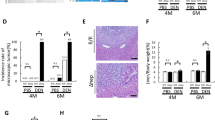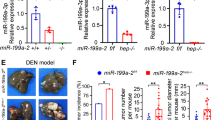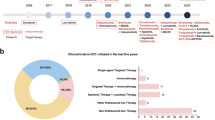Abstract
Pim-3, a proto-oncogene with serine/threonine kinase activity, was enhanced in hepatocellular carcinoma (HCC) tissues. To address the roles of Pim-3 in HCC development, we prepared transgenic mice that express human Pim-3 selectively in liver. The mice were born at a Mendelian ratio, were fertile and did not exhibit any apparent pathological changes in the liver until 1 year after birth. Pim-3-transgenic mouse-derived hepatocytes exhibited accelerated cell cycle progression. The administration of a potent hepatocarcinogen, diethylnitrosamine (DEN), induced accelerated proliferation of liver cells in Pim-3 transgenic mice in the early phase, compared with that observed for wild-type mice. Treatment with DEN induced lipid droplet accumulation with increased proliferating cell numbers 6 months after the treatment. Eventually, wild-type mice developed HCC with a frequency of 40% until 10 month after the treatment. Lipid accumulation was accelerated in Pim-3 transgenic mice with higher proliferating cell numbers, compared with that observed for wild-type mice. Pim-3 transgenic mice developed HCC with a higher incidence (80%) and a heavier burden, together with enhanced intratumoral CD31-positive vascular areas, compared with that observed for wild-type mice. These observations indicate that Pim-3 alone cannot cause, but can accelerate HCC development when induced by a hepatocarcinogen, such as DEN.
This is a preview of subscription content, access via your institution
Access options
Subscribe to this journal
Receive 50 print issues and online access
$259.00 per year
only $5.18 per issue
Buy this article
- Purchase on SpringerLink
- Instant access to full article PDF
Prices may be subject to local taxes which are calculated during checkout





Similar content being viewed by others
References
Bachmann M, Hennemann H, Xing PX, Hoffmann I, Moroy T . (2004). The oncogenic serine/threonine kinase Pim-1 phosphorylates and inhibits the activity of Cdc25C-associated kinase (C-TAK-1): a novel role for Pim-1 at the G2/M cell cycle checkpoint. J Biol Chem 279: 48319–48328.
Braun L, Mikumo R, Fausto N . (1989). Production of hepatocellular carcinoma by oval cells: cell cycle expression of c-myc and p53 at different stages of oval cell transformation. Cancer Res 49: 1554–1561.
Bullock AN, Debreczeni J, Amos AL, Knapp S, Turk BE . (2005). Structure and substrate specificity of the Pim-1 kinase. J Biol Chem 280: 41675–41682.
Chen L, Willis SN, Wei A, Smith BJ, Fletcher JI, Hinds MG et al. (2005). Differential targeting of prosurvival Bcl-2 proteins by their BH3-only ligands allows complementary apoptotic function. Mol Cell 17: 393–403.
Chung J, Koyama T, Ohsawa M, Shibamiya A, Hoshi A, Hirosawa S . (2007). 1,25(OH)(2)D(3) blocks TNF-induced monocytic tissue factor expression by inhibition of transcription factors AP-1 and NF-kappaB. Lab Invest 87: 540–547.
Deneen B, Welford SM, Ho T, Hernandez F, Kurland I, Denny CT . (2003). PIM3 proto-oncogene kinase is a common transcriptional target of divergent EWS/ETS oncoproteins. Mol Cell Biol 23: 3897–3908.
Farazi PA, DePinho RA . (2006). Hepatocellular carcinoma pathogenesis: from genes to environment. Nat Rev Cancer 6: 674–687.
Feldman JD, Vician L, Crispino M, Tocco G, Marcheselli VL, Bazan NG et al. (1998). KID-1, a protein kinase induced by depolarization in brain. J Biol Chem 273: 16535–16543.
Fujii C, Nakamoto Y, Lu P, Tsuneyama K, Popivanova BK, Kaneko S et al. (2005). Aberrant expression of serine/threonine kinase Pim-3 in hepatocellular carcinoma development and its role in the proliferation of human hepatoma cell lines. Int J Cancer 114: 209–218.
Hammerman PS, Fox CJ, Cinalli RM, Xu A, Wagner JD, Lindsten T et al. (2004). Lymphocyte transformation by Pim-2 is dependent on nuclear κB activation. Cancer Res 64: 8341–8348.
Hosono S, Chou MJ, Lee CS, Shih C . (1993). Infrequent mutation of p53 gene in hepatitis B virus positive primary hepatocellular carcinomas. Oncogene 8: 491–496.
Kamata H, Honda S, Maeda S, Chang L, Hirata H, Karin M . (2005). Reactive oxygen species promote TNFalpha-induced death and sustained JNK activation by inhibiting MAP kinase phosphatases. Cell 120: 649–661.
Li YY, Popivanova BK, Nagai Y, Ishikura H, Fujii C, Mukaida N . (2006). Pim-3, a proto-oncogene with serine/threonine kinase activity, is aberrantly expressed in human pancreatic cancer and phosphorylates bad to block bad-mediated apoptosis in human pancreatic cancer cell lines. Cancer Res 66: 6741–6747.
Ma W, Xia X, Stafford LJ, Yu C, Wang F, LeSage G et al. (2006). Expression of GCIP in transgenic mice decreases susceptibility to chemical hepatocarcinogenesis. Oncogene 25: 4207–4216.
Maeda S, Kamata H, Luo JL, Leffert H, Karin M . (2005). IKKbeta couples hepatocyte death to cytokine-driven compensatory proliferation that promotes chemical hepatocarcinogenesis. Cell 121: 977–990.
Manna SK, Mukhopadhyay A, Aggarwal BB . (2000). Leflunomide suppresses TNF-induced cellular responses: effects on NF-kappa B, activator protein-1, c-Jun N-terminal protein kinase, and apoptosis. J Immunol 165: 5962–5969.
Mochizuki T, Kitanaka C, Noguchi K, Muramatsu T, Asai A, Kuchino Y . (1999). Physical and functional interactions between Pim-1 kinase and Cdc25A phosphatase. Implications for the Pim-1-mediated activation of the c-Myc signaling pathway. J Biol Chem 274: 18659–18666.
Morishita D, Katayama R, Sekimizu K, Tsuruo T, Fujita N . (2008). Pim kinases promote cell cycle progression by phosphorylating and down-regulating p27Kip1 at the transcriptional and posttranscriptional levels. Cancer Res 68: 5076–5085.
Nakatsuru Y, Matsukuma S, Nemoto N, Sugano H, Sekiguchi M, Ishikawa T . (1993). O6-methylguanine-DNA methyltransgerase protects against nitrosamine-induced hepatocarcinogenesis. Proc Natl Acad Sci USA 90: 6468–6472.
Otani K, Korenaga M, Beard MR, Li K, Qian T, Showalter LA et al. (2005). Hepatitis C virus core protein, cytochrome P450 2E1, and alcohol produce combined mitochondrial injury and cytotoxicity in hepatoma cells. Gastroenterology 128: 96–107.
Pinkert CA, Ornitz DM, Brinster RL, Palmiter RD . (1987). An albumin enhancer located 10 kb upstream functions along with its promoter to direct efficient, liver-specific expression in transgenic mice. Genes Dev 1: 268–276.
Popivanova BK, Li YY, Zheng H, Omura K, Fujii C, Tsuneyama K et al. (2007). Proto-oncogene, Pim-3 with serine/threonine kinase activity, is aberrantly expressed in human colon cancer cells and can prevent Bad-mediated apoptosis. Cancer Sci 98: 321–328.
Qian KC, Wang L, Hickey ER, Studts J, Barringer K, Peng C et al. (2005). Structural basis of constitutive activity and a unique nucleotide binding mode of human Pim-1 kinase. J Biol Chem 280: 6130–6137.
Roberts RA, Kimber I . (1999). Cytokines in genotoxic hepatocarcinogenesis. Carcinogenesis 20: 1297–1401.
Sakurai T, Maeda S, Chang L, Karin M . (2006). Loss of hepatic NF-kappa B activity enhances chemical hepatocarcinogenesis through sustained c-Jun N-terminal kinase 1 activation. Proc Natl Acad Sci USA 103: 10544–10551.
Schwabe RF, Brenner DA . (2006). Mechanisms of liver injury. I. TNF-alpha-induced liver injury: role of IKK, JNK, and ROS pathways. Am J Physiol Gastrointest Liver Physiol 290: G583–G589.
She QB, Solit DB, Ye Q, O'Reilly KE, Lobo J, Rosen N . (2005). The BAD protein integrates survival signaling by EGFR/MAPK and PI3K/Akt kinase pathways in PTEN-deficient tumor cells. Cancer Cell 8: 287–297.
Tamura M, Arakaki N, Tsuboushi H, Takada H, Daikuhara Y . (1993). Enhancement of human hepatocyte growth factor production by interleukin-1α and -1β and tumor necrosis factor-α by fibroblasts in culture. J Biol Chem 268: 8140–8145.
Thorgeirsson SS, Grisham JW . (2002). Molecular pathogenesis of human hepatocellular carcinoma. Nat Genet 31: 339–346.
Udalova IA, Kwiatkowski D . (2001). Interaction of AP-1 with a cluster of NF-kappa B binding elements in the human TNF promoter region. Biochem Biophys Res Commun 289: 25–33.
Umemura T, Ichijo T, Yoshizawa K, Tanaka E, Kiyosawa K . (2009). Epidemiology of hepatocellular carcinoma in Japan. J Gastroenterol 44 (Suppl 19): 102–107.
Verna L, Whysner J, Williams GM . (1996). N-nitrosodiethylamine mechanistic data and risk assessment: bioactivation, DNA-adduct formation, mutagenicity, and tumor initiation. Pharmacol Ther 71: 57–81.
Wang Y, Ausman LM, Geenberg AS, Russel RM, Wang X-D . (2009). Nonalcoholic steatohepatitis induced by a high-fat diet promotes diethylnitrosamine-initiated early hepatocarcinogenesis in rats. In t J Cancer 124: 540–546.
Wang Z, Bhattacharya N, Mixter PF, Wei W, Sedivy J, Magnuson NS . (2002). Phosphorylation of the cell cycle inhibitor p21Cip1/WAF1 by Pim-1 kinase. Biochim Biophys Acta 1593: 45–55.
Wu Y, Li YY, Matsushima K, Baba T, Mukaida N . (2008). CCL3–CCR5 axis regulates intratumoral accumulation of leukocytes and fibroblasts and promotes angiogenesis in murine lung metastasis process. J Immunol 181: 6384–6393.
Yamada Y, Kirillova I, Peschon JJ, Fausto N . (1997). Initiation of liver growth by tumor necrosis factor: deficient liver regeneration in mice lacking type I tumor necrosis factor receptor. Proc Natl Acad Sci USA 94: 1441–1446.
Yang E, Zha J, Jockel J, Boise LH, Thompson CB, Korsmeyer SJ . (1995). Bad, a heterodimeric partner for Bcl-XL and Bcl-2, displaces Bax and promotes cell death. Cell 80: 285–291.
Yang X, Lu P, Fujii C, Nakamoto Y, Gao JL, Kaneko S et al. (2006). Essential contribution of a chemokine, CCL3, and its receptor, CCR1, to hepatocellular carcinoma progression. Int J Cancer 118: 1869–1876.
Yoshida S, Ono M, Shono T, Izumi H, Ishibashi T, Suzuki H et al. (1997). Involvement of interleukin-8, vascular endothelial growth factor, and basic fibroblast growth factor in tumor necrosis factor α-dependent angiogenesis. Mol Cell Biol 17: 4015–4023.
Zemskova M, Sahakian E, Bashkirova S, Lilly M . (2008). The PIM1 kinase is a critical component of a survival pathway activated by docetaxel and promotes survival of docetaxel-treated prostate cancer cells. J Biol Chem 283: 20635–20644.
Zha J, Harada H, Yang E, Jockel J, Korsmeyer SJ . (1996). Serine phosphorylation of death agonist BAD in response to survival factor results in binding to 14-3-3 not BCL-X(L). Cell 87: 619–628.
Zheng HC, Tsuneyama K, Takahashi H, Miwa S, Sugiyama T, Popivanova BK et al. (2008). Aberrant Pim-3 expression is involved in gastric adenoma-adenocarcinoma sequence and cancer progression. J Cancer Res Clin Oncol 134: 481–488.
Zheng Y, Chen WL, Louie SG, Yen TS, Ou JH . (2007). Hepatitis B virus promotes hepatocarcinogenesis in transgenic mice. Hepatology 45: 16–21.
Author information
Authors and Affiliations
Corresponding author
Ethics declarations
Competing interests
The authors declare no conflict of interest.
Rights and permissions
About this article
Cite this article
Wu, Y., Wang, Y., Nakamoto, Y. et al. Accelerated hepatocellular carcinoma development in mice expressing the Pim-3 transgene selectively in the liver. Oncogene 29, 2228–2237 (2010). https://doi.org/10.1038/onc.2009.504
Received:
Revised:
Accepted:
Published:
Issue date:
DOI: https://doi.org/10.1038/onc.2009.504
Keywords
This article is cited by
-
CRISPR/Cas9-mediated knockout of PIM3 suppresses tumorigenesis and cancer cell stemness in human hepatoblastoma cells
Cancer Gene Therapy (2022)
-
The kinase polypharmacology landscape of clinical PARP inhibitors
Scientific Reports (2020)
-
mTORC1 suppresses PIM3 expression via miR-33 encoded by the SREBP loci
Scientific Reports (2017)
-
The role of PIM1/PIM2 kinases in tumors of the male reproductive system
Scientific Reports (2016)
-
Differential expression of Pim-3, c-Myc, and p-p27 proteins in adenocarcinomas of the gastric cardia and distal stomach
Tumor Biology (2014)



